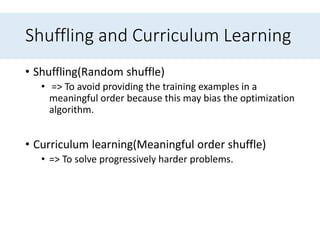An overview of gradient descent optimization algorithms
- 1. An overview of gradient descent optimization algorithms Ruder, Sebastian. "An overview of gradient descent optimization algorithms." arXiv preprint arXiv:1609.04747 (2016). Twitter : @St_Hakky
- 2. Overview of this paper • Gradient descent optimization algorithms are often used as black-box optimizers. • This paper provides the reader with intuitions with regard to the behavior of different algorithms that will allow her to put them to use.
- 3. Contents 1. Introduction 2. Gradient descent variants 3. Challenges 4. Gradient descent optimization algorithms 5. Parallelizing and distributing SGD 6. Additional strategies for optimizing SGD 7. Conclusion
- 4. Contents 1. Introduction 2. Gradient descent variants 3. Challenges 4. Gradient descent optimization algorithms 5. Parallelizing and distributing SGD 6. Additional strategies for optimizing SGD 7. Conclusion
- 5. Gradient Descent is often used as black-box tools • Gradient descent is popular algorithm to perform optimization of deep learning. • Many Deep Learning library contains various gradient descent algorithms. • Example : Keras, Chainer, Tensorflow… • However, these algorithms often used as black-box tools and many people don’t understand their strength and weakness. • We will learn this.
- 6. Gradient Descent • Gradient descent is a way to minimize an objective function 𝐽(𝜃) • 𝐽(𝜃): Objective function • 𝜃 ∈ 𝑅 𝑑:Model’s parameters • 𝜂:Learning rate. This determines the size of the steps we take to reach a (local) minimum. 𝐽(𝜃) 𝜃 𝜃 = 𝜃 − 𝜂 ∗ 𝛻𝜃 𝐽(𝜃) Update equation 𝛻𝜃 𝐽(𝜃) 𝑙𝑜𝑐𝑎𝑙 𝑚𝑖𝑛𝑖𝑚𝑢𝑚 𝜃∗
- 7. Contents 1. Introduction 2. Gradient descent variants 3. Challenges 4. Gradient descent optimization algorithms 5. Parallelizing and distributing SGD 6. Additional strategies for optimizing SGD 7. Conclusion
- 8. Gradient descent variants • There are three variants of gradient descent. • Batch gradient descent • Stochastic gradient descent • Mini-batch gradient descent • The difference of these algorithms is the amount of data. 𝜃 = 𝜃 − 𝜂 ∗ 𝛻𝜃 𝐽(𝜃) Update equation This term is different with each method
- 9. Trade-off • Depending on the amount of data, they make a trade-off : • The accuracy of the parameter update • The time it takes to perform an update. Method Accuracy Time Memory Usage Online Learning Batch gradient descent ○ Slow High × Stochastic gradient descent △ High Low ○ Mini-batch gradient descent ○ Midium Midium ○
- 10. Batch gradient descent This method computes the gradient of the cost function with the entire training dataset. 𝜃 = 𝜃 − 𝜂 ∗ 𝛻𝜃 𝐽(𝜃) Update equation Code We need to calculate the gradients for the whole dataset to perform just one update.
- 11. Batch gradient descent • Advantage • It is guaranteed to converge to the global minimum for convex error surfaces and to a local minimum for non- convex surfaces. • Disadvantages • It can be very slow. • It is intractable for datasets that do not fit in memory. • It does not allow us to update our model online.
- 12. Stochastic gradient descent This method performs a parameter update for each training example 𝑥 𝑖 and label 𝑦(𝑖). 𝜃 = 𝜃 − 𝜂 ∗ 𝛻𝜃 𝐽(𝜃; 𝑥 𝑖 ; 𝑦(𝑖)) Update equation Code We need to calculate the gradients for the whole dataset to perform just one update. Note : we shuffle the training data at every epoch
- 13. Stochastic gradient descent • Advantage • It is usually much faster than batch gradient descent. • It can be used to learn online. • Disadvantages • It performs frequent updates with a high variance that cause the objective function to fluctuate heavily.
- 14. The fluctuation : Batch vs SGD ・Batch gradient descent converges to the minimum of the basin the parameters are placed in and the fluctuation is small. https://wikidocs.net/3413 ・SGD’s fluctuation is large but it enables to jump to new and potentially better local minima. However, this ultimately complicates convergence to the exact minimum, as SGD will keep overshooting
- 15. Learning rate of SGD • When we slowly decrease the learning rate, SGD shows the same convergence behaviour as batch gradient descent • It almost certainly converging to a local or the global minimum for non-convex and convex optimization respectively.
- 16. Mini-batch gradient descent This method takes the best of both batch and SGD, and performs an update for every mini-batch of 𝑛. 𝜃 = 𝜃 − 𝜂 ∗ 𝛻𝜃 𝐽(𝜃; 𝑥 𝑖:𝑖+𝑛 ; 𝑦(𝑖:𝑖+𝑛)) Update equation Code
- 17. Mini-batch gradient descent • Advantage : • It reduces the variance of the parameter updates. • This can lead to more stable convergence. • It can make use of highly optimized matrix optimizations common to deep learning libraries that make computing the gradient very efficiently. • Disadvantage : • We have to set mini-batch size. • Common mini-batch sizes range between 50 and 256, but can vary for different applications.
- 18. Contents 1. Introduction 2. Gradient descent variants 3. Challenges 4. Gradient descent optimization algorithms 5. Parallelizing and distributing SGD 6. Additional strategies for optimizing SGD 7. Conclusion
- 19. Challenges • Mini-batch gradient descent offers a few challenges. • Choosing a proper learning rate is difficult. • The settings of learning rate schedule is difficult. • Changing learning rate for each parameter is difficult. • Avoiding getting trapped in highly non-convex error functions’ numerous suboptimal local minima is difficult
- 20. Choosing a proper learning rate can be difficult • Learning rate is too small • => This is painfully slow convergence • Learning rate is too large • => This can hinder convergence and cause the loss function to fluctuate around the minimum or even to diverge. • Problem : How do we set learning rate?
- 21. The settings of learning rate schedule is difficult • When we use learning rate schedules method, we have to define schedules and thresholds in advance • They are unable to adapt to a dataset’s characteristics.
- 22. Changing learning rate for each parameter is difficult • Situation : • Data is sparse • Features have very different frequencies • What we want to do : • we might not want to update all of them to the same extent. • Problem : • If we update parameters at the same learning late, it performs a larger update for rarely occurring features.
- 23. Avoiding getting trapped in highly non-convex error functions’ numerous suboptimal local minima • Dauphin[5] argue that the difficulty arises in fact not from local minima but from saddle points. • Saddle points are at the places that one dimension slopes up and another slopes down. • These saddle points are usually surrounded by a plateau of the same error as the gradient is close to zero in all dimensions. • This makes it hard for SGD to escape. [5] Yann N. Dauphin, Razvan Pascanu, Caglar Gulcehre, Kyunghyun Cho, Surya Ganguli, and Yoshua Bengio. Identifying and attacking the saddle point problem in high-dimensional nonconvex optimization. arXiv, pages 1–14, 2014.
- 24. Contents 1. Introduction 2. Gradient descent variants 3. Challenges 4. Gradient descent optimization algorithms 5. Parallelizing and distributing SGD 6. Additional strategies for optimizing SGD 7. Conclusion
- 25. Gradient descent optimization algorithms • To deal with the challenges, some algorithms are widely used by the Deep Learning community. • Momentum • Nesterov accelerated gradient • Adagrad • Adadelta • RMSprop • Adam • Visualization of algorithms • Which optimizer to use?
- 26. The difficulty of SGD • SGD has trouble navigating ravines which are common around local optima. Areas where the surface curves much more steeply in one dimension than in another is very difficult for SGD.
- 27. The difficulty of SGD • SGD oscillates across the slopes of the ravine while only making hesitant progress along the bottom towards the local optimum.
- 28. Momentum Momentum is a method that helps accelerate SGD. It does this by adding a fraction 𝛾 of the update vector of the past time step to the current update vector. The momentum term 𝛾 is usually set to 0.9 or a similar value.
- 29. Momentum Momentum is a method that helps accelerate SGD. It does this by adding a fraction 𝛾 of the update vector of the past time step to the current update vector The momentum term 𝛾 is usually set to 0.9 or a similar value. The ball accumulates momentum as it rolls downhill, becoming faster and faster on the way.
- 31. Why Momentum Really Works Demo : http://distill.pub/2017/momentum/ The momentum term increases for dimensions whose gradients point in the same directions. The momentum term reduces updates for dimensions whose gradients change directions.
- 32. Nesterov accelerated gradient • However, a ball that rolls down a hill, blindly following the slope, is highly unsatisfactory. • We would like to have a smarter ball that has a notion of where it is going so that it knows to slow down before the hill slopes up again. • Nesterov accelerated gradient gives us a way of it.
- 33. Nesterov accelerated gradient Approximation of the next position of the parameters(predict)
- 34. Nesterov accelerated gradient Approximation of the next position of the parameters(predict) Approximation of the next position of the parameters’ gradient(correction)
- 35. Nesterov accelerated gradient Blue line : predict Red line : correction Green line :accumulated gradient Approximationof the next position of the parameters(predict) Approximationof the next position of the parameters’ gradient(correction)
- 36. Nesterov accelerated gradient Blue line : predict Red line : correction Green line :accumulated gradient Approximationof the next position of the parameters(predict) Approximationof the next position of the parameters’ gradient(correction)
- 37. Nesterov accelerated gradient Blue line : predict Red line : correction Green line :accumulated gradient Approximationof the next position of the parameters(predict) Approximationof the next position of the parameters’ gradient(correction)
- 38. Nesterov accelerated gradient Blue line : predict Red line : correction Green line :accumulated gradient Approximationof the next position of the parameters(predict) Approximationof the next position of the parameters’ gradient(correction)
- 39. Nesterov accelerated gradient Blue line : predict Red line : correction Green line :accumulated gradient Approximationof the next position of the parameters(predict) Approximationof the next position of the parameters’ gradient(correction)
- 40. Nesterov accelerated gradient Blue line : predict Red line : correction Green line :accumulated gradient Approximationof the next position of the parameters(predict) Approximationof the next position of the parameters’ gradient(correction)
- 41. Nesterov accelerated gradient • This anticipatory update prevents us from going too fast and results in increased responsiveness. • Now , we can adapt our updates to the slope of our error function and speed up SGD in turn.
- 42. What’s next…? • We also want to adapt our updates to each individual parameter to perform larger or smaller updates depending on their importance. • Adagrad • Adadelta • RMSprop • Adam
- 43. Adagrad • Adagrad adapts the learning rate to the parameters • Performing larger updates for infrequent • Performing smaller updates for frequent parameters. • Ex. • Training large-scale neural nets at Google that learned to recognize cats in Youtube videos.
- 44. Different learning rate for every parameter • Previous methods : • we used the same learning rate 𝜼 for all parameters 𝜽 • Adagrad : • It uses a different learning rate for every parameter 𝜃𝑖 at every time step 𝑡
- 45. Adagrad Adagrad SGD 𝐺𝑡 = ℝ 𝑑×𝑑 ⋯ ⋯ ⋯ ⋯ ⋯ ⋯ ⋯⋯ ⋯ ⋯⋯ ⋯ Vectorize
- 46. Adagrad Adagrad SGD Adagrad modifies the general learning rate 𝜼 based on the past gradients that have been computed for 𝜽𝒊 𝐺𝑡 = ℝ 𝑑×𝑑 ⋯ ⋯ ⋯ ⋯ ⋯ ⋯ ⋯⋯ ⋯ ⋯⋯ ⋯ Vectorize
- 47. Adagrad Adagrad SGD 𝐺𝑡 is a diagonal matrix where each diagonal element (𝑖,𝑖) is the sum of the squares of the gradients 𝜃𝑖 up to time step 𝑡. 𝐺𝑡 = ℝ 𝑑×𝑑 ⋯ ⋯ ⋯ ⋯ ⋯ ⋯ ⋯⋯ ⋯ ⋯⋯ ⋯ Vectorize
- 48. Adagrad Adagrad SGD 𝜀 is a smoothing term that avoids division by zero (usually on the order of 1e − 8). 𝐺𝑡 = ℝ 𝑑×𝑑 ⋯ ⋯ ⋯ ⋯ ⋯ ⋯ ⋯⋯ ⋯ ⋯⋯ ⋯ Vectorize
- 49. Adagrad’s advantages • Advantages : • It is well-suited for dealing with sparse data. • It greatly improved the robustness of SGD. • It eliminates the need to manually tune the learning rate.
- 50. Adagrad’s disadvantage • Disadvantage : • Main weakness is its accumulation of the squared gradients in the denominator.
- 51. Adagrad’s disadvantage • The disadvantage causes the learning rate to shrink and become infinitesimally small. The algorithm can no longer acquire additional knowledge. • The following algorithms aim to resolve this flaw. • Adadelta • RMSprop • Adam
- 52. Adadelta : extension of Adagrad • Adadelta is an extension of Adagrad. • Adagrad : • It accumulate all past squared gradients. • Adadelta : • It restricts the window of accumulated past gradients to some fixed size 𝑤.
- 53. Adadelta • Instead of inefficiently storing, the sum of gradients is recursively defined as a decaying average of all past squared gradients. • 𝐸[𝑔2] 𝑡 :The running average at time step 𝑡. • 𝛾 : A fraction similarly to the Momentum term, around 0.9
- 55. Adadelta SGDAdagrad Adadelta Replace the diagonal matrix 𝐺𝑡 with the decaying average over past squared gradients 𝐸[𝑔2] 𝑡
- 56. Adadelta SGDAdagrad Adadelta Adadelta Replace the diagonal matrix 𝐺𝑡 with the decaying average over past squared gradients 𝐸[𝑔2] 𝑡
- 57. Update units should have the same hypothetical units • The units in this update do not match and the update should have the same hypothetical units as the parameter. • As well as in SGD, Momentum, or Adagrad • To realize this, first defining another exponentially decaying average
- 59. Adadelta AdadeltaAdadelta We approximate RMS with the RMS of parameter updates until the previous time step.
- 60. Adadelta update rule • Replacing the learning rate 𝜂 in the previous update rule with 𝑅𝑀𝑆[∆𝜃] 𝑡−1 finally yields the Adadelta update rule: • Note : we do not even need to set a default learning rate
- 61. RMSprop RMSprop and Adadelta have both been developed independently around the same time to resolve Adagrad’s radically diminishing learning rates. RMSprop
- 62. RMSprop RMSprop as well divides the learning rate by an exponentially decaying average of squared gradients. RMSprop Hinton suggests 𝛾 to be set to 0.9, while a good default value for the learning rate 𝜂 is 0.001.
- 63. Adam • Adam’s feature : • Storing an exponentially decaying average of past squared gradients 𝑣 𝑡 like Adadelta and RMSprop • Keeping an exponentially decaying average of past gradients 𝑚 𝑡, similar to momentum. The first moment (the mean) The second moment (the uncentered variance)
- 64. Adam • As 𝑚 𝑡 and 𝑣 𝑡 are initialized as vectors of 0’s, they are biased towards zero. • Especially during the initial time steps • Especially when the decay rates are small • (i.e. β1 and β2 are close to 1). • Counteracting these biases in Adam Adam Note : default values of 0.9 for 𝛽1, 0.999 for 𝛽2, and 10−8 for 𝜀
- 65. Visualization of algorithms • As we can see, Adagrad, Adadelta, RMSprop, and Adam are most suitable and provide the best convergence for these scenarios.
- 66. Which optimizer to use? • If your input data is sparse…? • You likely achieve the best results using one of the adaptive learning-rate methods. • An additional benefit is that you will not need to tune the learning rate
- 67. Which one is best? : Adagrad/Adadelta/RMSpro/Adam • Adagrad, RMSprop, Adadelta, and Adam are very similar algorithms that do well in similar circumstances. • Kingma et al. show that its bias-correction helps Adam slightly outperform RMSprop. • Insofar, Adam might be the best overall choice.
- 68. Interesting Note • Interestingly, many recent papers use SGD • without momentum and a simple learning rate annealing schedule. • SGD usually achieves to find a minimum but it takes much longer time than others. • However, it is a robust initialization and schedule, and may get stuck in saddle points rather than local minima.
- 69. Contents 1. Introduction 2. Gradient descent variants 3. Challenges 4. Gradient descent optimization algorithms 5. Parallelizing and distributing SGD 6. Additional strategies for optimizing SGD 7. Conclusion
- 70. Parallelizing and distributing SGD • Distributing SGD is an obvious choice to speed it up further. • Now, we can have much data and the availability of low- commodity clusters. • SGD is inherently sequential. • If we run it step-by-step • Good convergence • Slow • If we run it asynchronously • Faster • Suboptimal communication between workers can lead to poor convergence.
- 71. Parallelizing and distributing SGD • The following algorithms and architectures are for optimizing parallelized and distributed SGD. • Hogwild! • Downpour SGD • Delay-tolerant Algorithms for SGD • TensorFlow • Elastic Averaging SGD
- 72. Hogwild! • This allows performing SGD updates in parallel on CPUs. • Processors are allowed to access shared memory without locking the parameters • Note : This only works if the input data is sparse
- 73. Downpour SGD … … Parameter server Storing and Updating a fraction of the model’s parameters Downpour SGD runs multiple replicas of a model in parallel on subsets of the training data. Send their updates model
- 74. Downpour SGD • However, as replicas don’t communicate with each other e.g. by sharing weights or updates, their parameters are continuously at risk of diverging, hindering convergence.
- 75. Delay-tolerant Algorithms for SGD • McMahan and Streeter [11] extend AdaGrad to the parallel setting by developing delay-tolerant algorithms that not only adapt to past gradients, but also to the update delays.
- 76. TensorFlow • Tensorflow is already used internally to perform computations on a large range of mobile devices as well as on large-scale distributed systems. • It relies on a computation graph that is split into a subgraph for every device, while communication takes place using Send/Receive node pairs.
- 77. Elastic Averaging SGD(EASGD) • Should read paper to understand this. • Ioffe, Sergey, and Christian Szegedy. "Batch normalization: Accelerating deep network training by reducing internal covariate shift." arXiv preprint arXiv:1502.03167 (2015).
- 78. Contents 1. Introduction 2. Gradient descent variants 3. Challenges 4. Gradient descent optimization algorithms 5. Parallelizing and distributing SGD 6. Additional strategies for optimizing SGD 7. Conclusion
- 79. Additional strategies for optimizing SGD • Shuffling and Curriculum Learning • Batch normalization • Early stopping • Gradient noise
- 80. Shuffling and Curriculum Learning • Shuffling(Random shuffle) • => To avoid providing the training examples in a meaningful order because this may bias the optimization algorithm. • Curriculum learning(Meaningful order shuffle) • => To solve progressively harder problems.
- 81. Batch normalization • By making normalization part of the model architecture, we can use higher learning rates and pay less attention to the initialization parameters. • Batch normalization additionally acts as a regularizer, reducing the need for Dropout.
- 82. Early stopping • According to Geoff Hinton • “Early stopping (is) beautiful free lunch” • In the training of each epoch, we use validation data to check the learning is already convergence. • If it is true, we stop the learning.
- 83. Gradient noise Adding this noise makes networks more robust to poor initialization and gives the model more chances to escape and find new local minima. Add noise to each gradient update Annealing the variance according to the following schedule
- 84. Contents 1. Introduction 2. Gradient descent variants 3. Challenges 4. Gradient descent optimization algorithms 5. Parallelizing and distributing SGD 6. Additional strategies for optimizing SGD 7. Conclusion
- 85. Conclusion • Gradient descent variants • Batch/Mini-Batch/SGD • Challenges for Gradient descent • Gradient descent optimization algorithms • Momentum/Nesterov accelerated gradient • Adagrad/Adadelta/RMSprop/Adam • Parallelizing and distributing SGD • Hogwild!/Downpour SGD/Delay-tolerant Algorithms for SGD/TensorFlow/Elastic Averaging SGD • Additional strategies for optimizing SGD • Shuffling and Curriculum Learning/Batch normalization/Early stopping/Gradient noise
- 86. Thank you ;)
Editor's Notes
- #4: In the course of this overview, we look at different variants of gradient descent, summarize challenges, introduce the most common optimization algorithms, review architectures in a parallel and distributed setting, and investigate additional strategies for optimizing gradient descent.
- #24: Saddle : (馬などの)鞍(くら),(自転車・バイクなどの)サドル,鞍下肉,(山の)鞍部(あんぶ) Plateau :高原,台地,(グラフの)平坦域,(景気・学習などの)高原状態,プラトー
- #78: EASGD links the parameters of the workers of asynchronous SGD with an elastic force, i.e. a center variable stored by the parameter server. This allows the local variables to fluctuate further from the center variable, which in theory allows for more exploration of the parameter space. They show empirically that this increased capacity for exploration leads to improved performance by finding new local optima.
- #86: In the course of this overview, we look at different variants of gradient descent, summarize challenges, introduce the most common optimization algorithms, review architectures in a parallel and distributed setting, and investigate additional strategies for optimizing gradient descent.





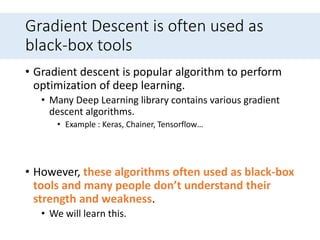

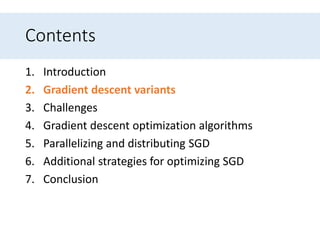

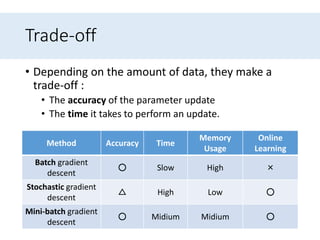







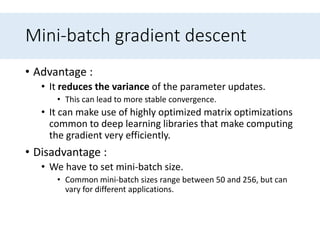

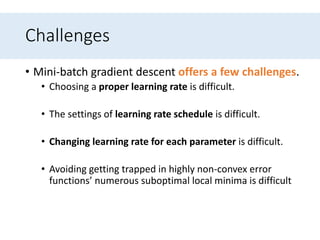

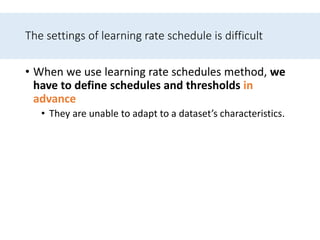

![Avoiding getting trapped in highly non-convex error
functions’ numerous suboptimal local minima
• Dauphin[5] argue that the difficulty arises in fact not
from local minima but from saddle points.
• Saddle points are at the places that one dimension slopes
up and another slopes down.
• These saddle points are usually surrounded by a
plateau of the same error as the gradient is close to
zero in all dimensions.
• This makes it hard for SGD to escape.
[5] Yann N. Dauphin, Razvan Pascanu, Caglar Gulcehre, Kyunghyun Cho, Surya Ganguli, and Yoshua Bengio. Identifying and
attacking the saddle point problem in high-dimensional nonconvex optimization. arXiv, pages 1–14, 2014.](https://image.slidesharecdn.com/anoverviewofgradientdescentoptimizationalgorithms-170414055411/85/An-overview-of-gradient-descent-optimization-algorithms-23-320.jpg)






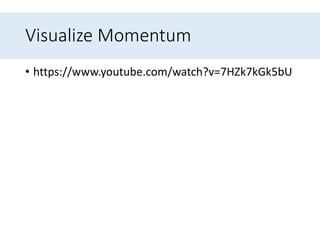








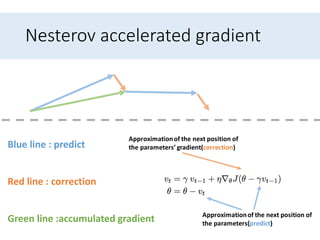


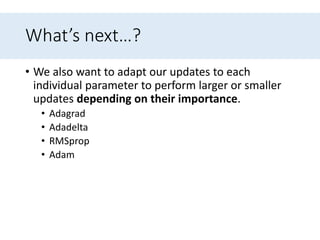




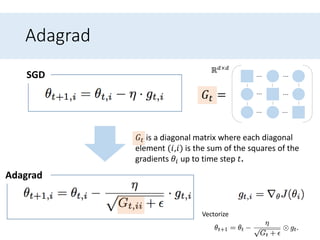





![Adadelta
• Instead of inefficiently storing, the sum of gradients
is recursively defined as a decaying average of all
past squared gradients.
• 𝐸[𝑔2] 𝑡 :The running average at time step 𝑡.
• 𝛾 : A fraction similarly to the Momentum term, around
0.9](https://image.slidesharecdn.com/anoverviewofgradientdescentoptimizationalgorithms-170414055411/85/An-overview-of-gradient-descent-optimization-algorithms-53-320.jpg)

![Adadelta
SGDAdagrad
Adadelta
Replace the diagonal matrix 𝐺𝑡 with the decaying
average over past squared gradients 𝐸[𝑔2] 𝑡](https://image.slidesharecdn.com/anoverviewofgradientdescentoptimizationalgorithms-170414055411/85/An-overview-of-gradient-descent-optimization-algorithms-55-320.jpg)
![Adadelta
SGDAdagrad
Adadelta Adadelta
Replace the diagonal matrix 𝐺𝑡 with the decaying
average over past squared gradients 𝐸[𝑔2] 𝑡](https://image.slidesharecdn.com/anoverviewofgradientdescentoptimizationalgorithms-170414055411/85/An-overview-of-gradient-descent-optimization-algorithms-56-320.jpg)
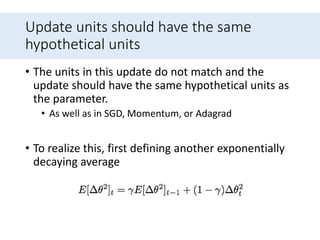


![Adadelta update rule
• Replacing the learning rate 𝜂 in the previous update
rule with 𝑅𝑀𝑆[∆𝜃] 𝑡−1 finally yields the Adadelta
update rule:
• Note : we do not even need to set a default
learning rate](https://image.slidesharecdn.com/anoverviewofgradientdescentoptimizationalgorithms-170414055411/85/An-overview-of-gradient-descent-optimization-algorithms-60-320.jpg)














![Delay-tolerant Algorithms for SGD
• McMahan and Streeter [11] extend AdaGrad to the
parallel setting by developing delay-tolerant
algorithms that not only adapt to past gradients,
but also to the update delays.](https://image.slidesharecdn.com/anoverviewofgradientdescentoptimizationalgorithms-170414055411/85/An-overview-of-gradient-descent-optimization-algorithms-75-320.jpg)




